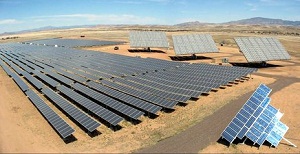Reviewing last week's solar energy news
 The past week was generally a good one for the solar industry. Even in the ravaging disasters facing Japan, the solar industry offers hope of helping the country make a quicker recovery than previously possible.
The past week was generally a good one for the solar industry. Even in the ravaging disasters facing Japan, the solar industry offers hope of helping the country make a quicker recovery than previously possible.
Perhaps one of the most interesting pieces of news didn’t have to do with large-scale photovoltaics, but with personal-sized photovoltaics. Last week Wysips debuted a working prototype of its transparent photovoltaic cells for portable devices at the CTIA Wireless convention, where it won an Emerging Technology award. The company said the technology, which will cost manufacturers about $1 for a 4-inch cell, should see commercial availability in about a year. The transparent display can be integrated into cellphones, personal digital assistants e-books, tablets and more.
In Japan, the twin disasters of the earthquake and the tsunami offer the potential for solar power to play a role in rebuilding that part of Japan. SunPower Corp. (Nasdaq: SPWRB) was expanding its presence in Japan prior to the disasters and is likely to continue to do so.
Overall, the Asian market is really warming up to solar. India and China, the world’s two most populous countries are looking to solar and wind to help them become more developed nations. But Japan and Australia are also likely going to become bigger players, according to a new report from PHOTON Consulting.
Even Tibet is benefitting from large-scale solar—and at new heights. Chinese company Suntech Power Holdings Inc. (NYSE: STP) said it will install one of the world’s highest photovoltaic installations at roughly 13,123 feet above sea level. The 10 megawatt photovoltaic farm will provide power stability in the region.
Still, the U.S., with the highest electric consumption per capita in the world, is poised to become the largest market for solar as incentives in Europe continue to dry up. Though, a Clean Energy Trends report said the U.S. market may be hampered by a lack of strong incentives at the federal level.
Usually, California dominates the solar news. But other states are becoming bigger solar players. Take, for instance, Colorado. Last week saw a number of big developments. The largest utility in the state, Xcel Energy (NYSE: XEL) resumed its Solar Rewards incentive program—and received an absolute crush of applications, showing the popularity of solar in the state.
In what might be a first, the Niobrara Energy Park triple-hybrid electricity project was approved by Weld County, Colo., officials. The project includes solar and wind farms as well as a natural gas-fired generator.
Other states are seeing more solar action as well. One Block off the Grid launched promotions in Philadelphia and in Long Island, N.Y., that reduce the cost of residential solar by 15 percent. It’s also planning to launch more discount programs in other cities in the near future.
Hawaii also is becoming a bigger market for solar. The islands are pursuing an energy strategy, capitalizing on the state’s tropical climate and trying to get away from fossil fuel-fired electric generation, which has high transportation costs.
California’s still the largest market, however. A veritable ton of homes in the state will soon have solar on them, thanks to at least two new projects. GRID Alternatives reached an agreement with Yingli Solar (NYSE: YGE) subsidiary Yingli Green Energy Americas to put solar on 400 low-income homes in California. And KB Home (NYSE: KBH) said it will include solar power as a standard feature on 888 new homes in California communities that it is now building.
To meet all of this demand across the world, companies like First Solar (Nasdaq: FSLR) are scaling up production in a big way. Last week the company announced that it broke ground on a new Vietnamese solar facility that, when completed, will produce 250 megawatts of photovoltaic modules annually.
Image courtesy of NREL.



